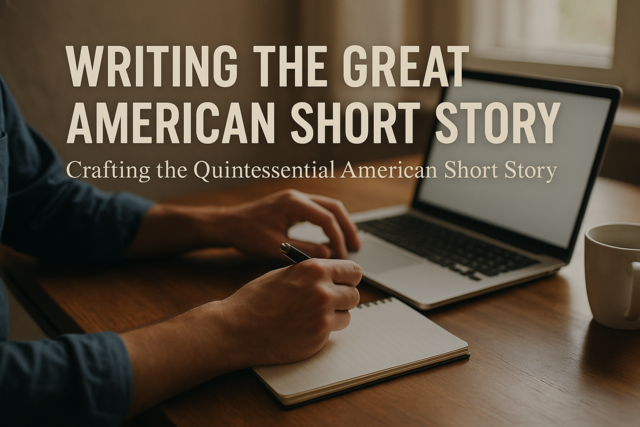While there will never be a unanimous agreement as to which element is the most pivotal, character development can often be found near the top, (if not at the very top), of the list.
A. Character Development: Definition
When we speak of character development, to what exactly are we referring?
In short, character development (characterization) is best summarized as the act of giving real-life qualities to fictional persons.
B. Quantity of Characters
Are there a set number of characters I should include in my novel?
Is there a number of characters that is too few or too many to include?
While there is no definitive number of characters to write into a story, experienced writers recommend including between three and five.
This number seems to work well for a number of reasons:
1 . It provides the writer with a sufficient amount of fodder from which to create a colorful and compelling read.
2 . It limits the number of back stories and descriptive passages the writer needs to invent.
3 . It offers the reader a chance to become fairly intimate with each of the novel's characters.
4 . It keeps the story on track, without getting bogged down by too many details.
C. Archetypes
By and large, three-dimensional characters are created, based upon key archetypes (stock characters). Archetypes may be both primitive and universal, comprising such general themes as: birth, death, coming of age, love, guilt, redemption, remorse, conflict between free will, and ultimate fate, family rivalries, and rites of passage. In addition, they may also encompass a full spectrum of characters, including the hero and the rebel, the religious zealot and the atheist, the do-gooder and the wanderer.
Let's look first at 'driver' characters. They are referred to by this term for they help to move the story along (drivers):
-
Protagonist -- The central "driver" of the story, he/she guides the action, based upon a series of well-thought decisions and critical assessments.
-
Antagonist -- Diametrically opposed, he/she serves to challenge the central character (protagonist).
-
Contagonist -- Along side the antagonist, he/she aids the antagonist's attempts to thwart the protagonist's progression.
-
Guardian/sage -- This character serves to protect, and/or advise, the protagonist throughout the story, by acting as his/her shield/conscience.
Next, we turn our attention to the "passenger" characters.
Viewed as supportive players, the passenger characters include:
-
The voice of reason -- A character responsible for making decisions based upon logic.
-
The emotional being -- Opposite of the voice of reason, he/she acts based upon feelings, as opposed to rational thought processes.
-
Sidekick/best friend -- Unconditionally supportive and loyal to the protagonist's plight, the sidekick/best friend is a dedicated helper and confidante.
-
Skeptic -- Essentially the opposite of the sidekick/best friend, the skeptic is negatively opposed to all the protagonist's efforts to move forward.
D. Three-Dimensional Versus Two-Dimensional
What differentiates three-dimensional characters from two-dimensional characters?
When writers create three-dimensional characters, they do what is necessary to fully "flesh them out."
By this we mean, writers create an entire persona for each character, complete with the following: descriptive back story, full set of strengths and weaknesses, hopes and dreams, fears and desires, etc. Most importantly, writers give three-dimensional characters the gift of "internal life."
In contrast, writers develop two-dimensional characters based upon a simplistic notion of how they are viewed from the outside world. Hence, with only an "external life" with which to work, two-dimensional characters lack the ability to dramatically change or progress in any sizable way.
Examples of Two- and Three-Dimensional Characters
To better understand the distinction between two- and three-dimensional characters, it may be helpful to first look at specific examples from the literary world.
Recently, J.K. Rowling, author of the Harry Potter series, was commended for her three-dimensional characters. Standing out from the pack, it was the character of Hermione Granger, (a bushy haired 'know-it-all'), who perhaps best exemplified Ms. Rowling's ability to create well-developed characters.
J.K. Rowling
In summary, we then could visualize Granger's gradual transformation occurring on an arc, whereby in plotting her changes at different points along a constant plane, her shift would be categorized as dynamic (versus static -- see next section). And, as a rule of thumb, when the characters' basic core changes over the course of a story, they typically tend to fall into the three-dimensional category, as opposed to the two-dimensional category.
This is due to the fact that a character is usually only two-dimensional if they remain basically the same over the course of the story. Should the character evolve into a better person or changed human being, then the writer has given them depth and gradients of qualities, as opposed to only black and white characteristics.
Even though the genre may be fictional, characters still need to be based upon real-life incidents, emotions, and interactions. Therefore, it is the writer's responsibility to bring depth and honesty to their leading line-up, and do so in way that is congruent with the world around them.
E. Dynamic Versus Static
Within the preceding paragraphs, we discussed the idea of mounting two- and three-dimensional characters. Usually the idea of static and dynamic characters goes hand-in-hand with the writer's decisions regarding how to best develop his/her roster of characters.
To understand the difference between static and dynamic, let's first provide a definition of each. Static relays a consistent state that does not veer much in any direction, or form, from its original position. Dynamic, on the other hand, relates to both the visible (external) and non-visible (internal) changes that the protagonist experiences.
Thus, because of the lack of change, and dearth of personality, we view a static character as being two-dimensional and unchanging. Succinctly put: How they are in the beginning of the novel is how they are at the end.
The writing for a three-dimensional character should bring real-life emotional issues to his/her pain, sorrow, fear. The result is then a realistic blend of differing traits and qualities.
F. Setting Up the Inciting Incident
Part of a character's back story often contains elements of inciting incident(s). What then, you ask, is an inciting incident?
According to Corey Blake, founder of the Writers Roundtable, a writing consultancy focusing on creative and non-fiction works, the inciting incident -- also referred to as the catalyst -- is the novel's turning point, whereby the story moves from orderly to chaotic. The inciting incident evolves from the characters' struggles to get what they want, despite the obstacles in their way (story's premise).
In order to come up with an extremely compelling inciting incident, (for it is, after all, the center of your novel), you will need to intermittently sprinkle specific elements of your character's back story throughout the novel to provide a sense of what is at the crux of his/her personal struggles.
This setting up of the story should include imagery of incidents that occurred in the protagonist's past which have made it difficult for him/her to accomplish his/her present goals.
For example, you may want to include a brief scene depicting your protagonist, Thad, who as a 7-year-old, was belittled by his mother, who hollered at him in front of the school because he forgot to grab his lunch sack before leaving the house.
To this day, Thad may feel fearful if everything is not in order. This has resulted in his inability to leave the house without checking it several times to be sure he did not forget anything. Thus, when confronted with a crisis situation, e.g., a major fire, Thad will have to either forgo his habitual double-checking, or face death.
G. Operative Qualifiers
What then drives the protagonist?
Essentially, everyone has a different take on this question.
A commonly held belief is that at the root of all three-dimensional characters' motivations, is fear and desire. The juxtaposition, however, arises in the form of the protagonist's desperate yearning to attain something, although he/she is terrified of the process required to get it.
Character Development: Summation
In short, in developing your characters, you will want to work in an organic manner, whereby you develop your characters before your overall storyline.
It is suggested that you use your characters to help move the storyline forward, or at least to benefit the central storyline.
Ensure your lead characters' development occurs in an arc-like movement, whereby, initially, we learn of protagonist's ordinary life (pre-conflict); then the conflict is introduced and the protagonist becomes somewhat affected; the antagonist comes in and does further damage, eventually leading up the point where the protagonist gets further debilitated until a solution arrives, and all is satisfactorily resolved.
Plot/Conflict Development
To fully understand "plot" and the contribution it makes to your story, it is helpful to first have a working definition for the term.
In many respects, a novel's plot can be likened to the culmination of a pattern of events. It might be helpful to think of a plot as being similar to a blueprint of occurrences, in that it not only helps guide the author's writing, but also equips readers with a framework for grasping the relationships that exist among the numerous characters and incidents in the story.
The key aspect of plot comes in the form of "conflict."
Defined as the struggle between two opposing forces, conflict delivers interest, suspense, and tension. At least one of the opposing forces is likely to be a person. This character -- usually the protagonist -- may experience up to four different types of conflicts at random times.
-
Struggle against nature
-
Struggle against another person (typically the antagonist)
-
Struggle against society
-
Struggle for mastery, whereby the protagonist does his/her best, yet still needs to compete with both the external and internal elements associated with the character.
Within literary works, seldom does a novel contain merely a single conflict. Rather, the compounded struggle, in which a protagonist goes up against someone, or something, is the type of conflict that has become customary.
Without conflict, it is very likely the plot would cease to exist. For this reason, the plot envelopes the range of characters engaged in conflicting activities, against opposing forces. Though such forces may be either physical (external), or spiritual (internal), the minimal requirement is that they must be in opposition to one another.
Take for example, a story in which the protagonist (Harry) desires to date Sally. In order for him to ask Sally out on a date, Harry needs to first overcome his intense fear of rejection. Hence, in this situation, Harry's fear of rejection serves as the conflict (internal and spiritual in nature). Yet, where does the opposition come in?
To answer this question, another element needs to be added to the story. For example, perhaps every time 35-year-old Harry starts to gain a bit of self-confidence, his mother (who lives in his apartment with him), begins to ruthlessly cut him down by saying, "No one would ever want to go out with you. Do you really think you have anything to offer someone?"
Hence, the conflict is Harry's own view of his self-worth, and his self-worth through the eyes of his mother. We now see how these two are in direct opposition to one another -- for Harry will continue to feel frozen until he finds a way to overcome his mother's negative diatribes.
B. Crisis
The point in the story where the struggle between the two forces comes to a head, is what is known as the "crisis." In our, "When Harry Did Not Meet Sally" example, we can easily instigate a crisis by creating a scene in which Harry challenges his mother, by kicking her out of his apartment.
In this scene, Harry will be addressing his biggest obstacle: shaking himself free of his mother, whose boisterous opinions have caused him to have terribly low self-esteem.
After Harry's big confrontation with his mother, the story will then reach a turning point whereby, at first, there will be a big build-up as to whether Harry will buckle once again and succumb to his bitter mother's uncaring retorts, or stand strong and be able to brush off any of his mother's last ditch efforts to once again get him back in her clutches.
C. Moments of Suspense
Within the story, there needs to be a sufficient build-up as to what the outcome will be. During this period known as the "moment of suspense," the reader should experience a feeling of uncertainty as to the characters' final fate.
In this context, suspense -- a most effective tool -- serves the purpose of holding the reader's interest. Often used in tandem with dramatic irony and foreshadowing, suspense keeps readers guessing the outcome of the story.
At times, the writer may even try to trip up the readers by allowing them to think the protagonist is simply going to backslide into the old situation, as opposed to moving forward and taking a chance by practicing a new behavior.
Further, building in suspense is what is known as a red herring, which is defined as an action, theme, or piece of information intended to lead the reader off track. These advanced literary techniques help the writer build additional intrigue into the story.
D. The Hook/Reeling Them In
Undoubtedly, you have heard the phrase, "You need a hook in order to reel in your reader."
But have you ever stopped long enough to really give this idea some reflection?
How, exactly, do you create a hook? And how do you continue to use hooks throughout your entire story?
Bookstore shoppers begin by browsing the shelves and tables and picking up those books whose covers catch their fancy.
Successful lead-in sentences contain:
-
Strong, attention-grabbing opening words
-
A specific voice
-
Irresistible ideas and images
-
Awe-inspired statements
Successful lead-in sentences do not contain:
-
Blatant or exploitive statements
-
Gimmicky words or phrases
-
Confusing ideas or sentiments
Succinctly put, effective lead-in sentences come across in a rather subtle manner; "Call me Ishmael," is one famous example. They do not attempt to shock or manipulate, but rather lure the reader with a series of well-orchestrated ideas that come across in a confident, intelligent, organized manner. A composed voice is important, for it indicates a sense about the writer and the way he/she talks, thinks, and, ultimately tackles the subject at hand.
The opening hook may also include a sprinkling of imagery that provides the reader with a little bit of insight into the setting of the story and an indication as to the major issue due to fall upon our protagonist.
Rather then immediately pitting your protagonist up against a master crime ring, or a killer with a gun to her head, you can merely introduce her character by picturing her prior to when her life takes a turn.
For example: Haltingly walking down the street in the pouring rain, Miranda feverishly attempts not to lock eyes with anyone as she clutches her thin raincoat to her soaking body, furtively seeking a safe place of refuge.
The reader should be lured into the story by this point, wondering such things as: From what does she seek refuge, and why is she caught in the rain?
Because the plot plays such a pivotal role in your story, you will definitely want to invest the time in creating a gripping hook that will draw the reader in, and hold their interest throughout. If you can accomplish this feat, you will have created what it is known as a page-turning novel.


























